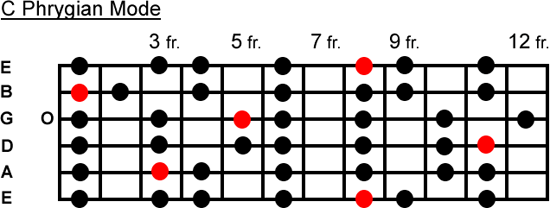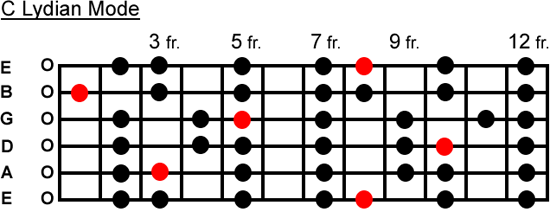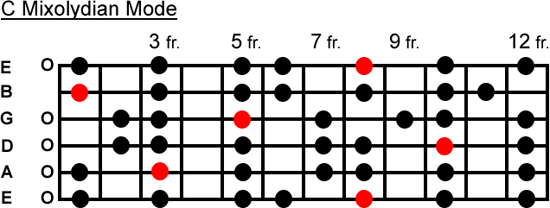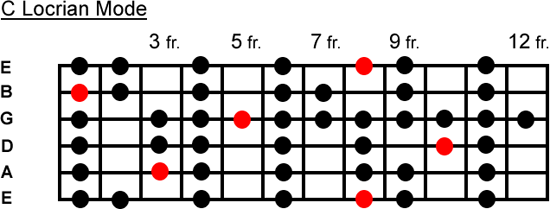Modes, what are they?
Modes are a set of different scales that all offspring of the major scale. Modes are used by players intentionally and sometimes by accident to add some spice and variety to music. They are generally more exotic or have a more specific vibe than the major or minor scales. If used creatively that can lift a bog standard piece of music into something a bit more interesting.
The major scale is their musical father. But before we explain how the modes are created and how exactly they are related to the major scale, lets just introduce each mode and try for now just to think of each mode as its own scale. Their relationship to the major scale we’ll dive into later. Don’t feel like you have to memorise and learn all of these, if any. Try them out and if you like the sound of them explore them further.
Ionian mode
First up is the Ionian mode. The Ionian mode is exactly the same as the major scale. So thats all that needs to be said about that!
Dorian mode
Next we have the Dorian mode. Using C as the root the Dorian mode has the following notes,
C D Eb F G A Bb C
So to construct the Dorian mode in any key we just need to use this formula, T indicates a whole tone gap and ST indicated a semi tone gap. R of course being the root. So the ‘T’ after the ‘R’ means the next note is a tone away.
R-T-ST-T-T-T-ST-R
Or if you prefer the fancy speak a Dorian mode is made from a Root, Major 2nd, Minor 3rd, perfect 4th, perfect 5th, major 6th and minor 7th. Below is a full diagram of the fret board showing all the note positions of the Dorian mode in C. The notes in red are the root notes, in this case the C. To get the Dorian mode in another key simply move the root note to the root you want. And remember to move the other notes an equal amount.

The Dorian mode has a soulful sound and is often used to make bluesy playing sound a bit more exotic or exciting.
Phrygian Mode
Using C as the root the Phrygian mode is as follows,
C Db Eb F G Ab Bb C
or for any key,
R-ST-T-T-T-ST-T-T-R
That’s a Root, minor 2nd, minor 3rd, perfect 4th, perfect 5th, minor 6th and a minor 7th.

The Phrygian mode can sound evil and haunting. It can also sometimes sound classical. Some say it sounds Spanish. Well which is it? I hear you ask. Try it yourself and let your ears decide!
Lydian Mode
Again using the C as root the Lydian mode is as follows
C D E F# G A B C
For any key that’s,
R-T-T-T-ST-T-T-R
So that’s a Root, major 2nd, major 3rd, augmented 4th, perfect 5th, major 6th and a major 7th.

The Lydian mode has a alien, mystical or futuristic sound. It’s often used in Jazz also.
Mixolydian Mode
Again using the C as root,
C D E F G A Bb C
For any key,
R-T-T-ST-T-T-ST-R
That’s a Root, major 2nd, major 3rd, perfect 4th, perfect 5th, major 6th and a minor 7th.

Mixolydian can sound bluesy and jazzy. Sometimes it can have a sad edge and vibe. I know these descriptions are quite vague and scatter gun. Last time I used the mixolydian it sounded to me to have a old fashioned 50’s rock and
Jazz sound. Again you’ll just have to try it for yourself.
Aeolian Mode
I like the Aeolian mode because it’s exactly the same as the minor scale so we don’t need to go into that!
Locrian Mode
In C the Locrian mode is as follows,
C Db Eb F Gb Ab Bb C
That’s a,
R-ST-T-T-ST-T-T-R
So that’s a root, minor 2nd, minor 3rd, perfect 4th, diminished 5th, minor 6th and a minor 7th.

Locrian mode is sometimes used in Jazz and has a weird sound that can sound unnatural or ‘wrong’. In the right hands it has its uses and applications. Unfortunately those hands aren’t mine! Maybe yours?
Right so those are the seven modes. Now we will dive into the messy business of where these modes come from.
The modes are all made, by taking the major scale and taking one of the notes in the major scale and making that note the root.
The first time I heard that it didn’t make an ounce of sense. Changing the root? Isn’t that just playing the major scale in a different key? The best way to explain this is to demonstrate. First lets look at our best friend, or maybe in your case a annoying friend that wont go away, C major.
C Major
C D E F G A B
Now, the Dorian mode is made, by taking the 2nd note of the major scale, and making that the root. But we still keep all the same notes.
D Dorian
D E F G A B C
But this is very important, D dorian is NOT THE SAME as D major. D major is shown below,
D Major
D E F# A B C#
When we shift C major up to D major we shift all the notes in C major up the same amount. However when we changed C major into the D Dorian mode, we kept all the exact same notes from C major, we just put them in a different order. If we take D Dorian and put it in the key of C, we can see that even though it comes from C major it IS NOT the same. Lets put them next to each other to demonstrate this. Remember all we did is take D Dorian and move everything back a tone to make it C Dorian.
C Dorian
C D Eb F G A Bb
C major
C D E F G A B
So even though the Dorian mode is made by playing the 2nd note of a major scale as root it is in effect a different scale. All the other modes we introduced before are made in this fashion also.
Ionian mode is the same as major scale it’s the mode where you play the root of the major scale as the root. I hear you ask, if its the same why call it a mode and give it a different name? I haven’t the faintest idea. Most likely just for the sake of completeness. We just found out the Dorian mode comes from playing the 2nd note of a major scale as root. And then it just goes on in this order, the same order as we intoduced the modes above,
Ionian(major scale)
Dorian
Phyragian
Lydian
Milxolydian
Aeolian(minor scale)
Locrian
Seven notes in the major scale so we have seven modes.
Now my advice is to treat each mode as its own scale and learn them in that way without paying too much attention to all the messy business of where they came from and how they are made. However if you remember the order in which the modes come in, you can produce any of these modes on the fly as long as you remember your major scale. All you have to do is visualise the major scale positions, count down from the root how many notes you need to get to the mode you want and then move that note up or down the neck to get it in the right Key you need. And then re-build those same major scale shapes you’re used to around this new root.
Let’s say someone suddenly asks you to play in D phyragian. And like me you’ve never bothered to remember that full fret board diagram or the correct intervals. But I remember that phyragian is made from playing the 3rd note of the major scale as its root. So I take a major scale shape that’s most familar to me. My best friend C major. I go down three notes along the scale so I arrive at E. If I take this note as the root I will be playing E Phyragian, but I wanted D Phyragian. No problem I just move it back a tone to D. All the major scale shapes im used to I’ve also shifted back. Now with this new D note as Root vola! D phyragian.
Knowing where the modes come from can also help later when we dive into the lesson on how to make playing scales fit over a chord progression.
Don’t worry if you didn’t quite understand that, the best thing to do is learn each mode taking it as its own scale in that case. You can always come back to it later.
Have fun with the modes, good luck.
- Modes are a way of varying the standard major and minor scale sounds.
- Modes are made by changing the root of a major scale.
- At first learn a mode as it’s own individual scale.
